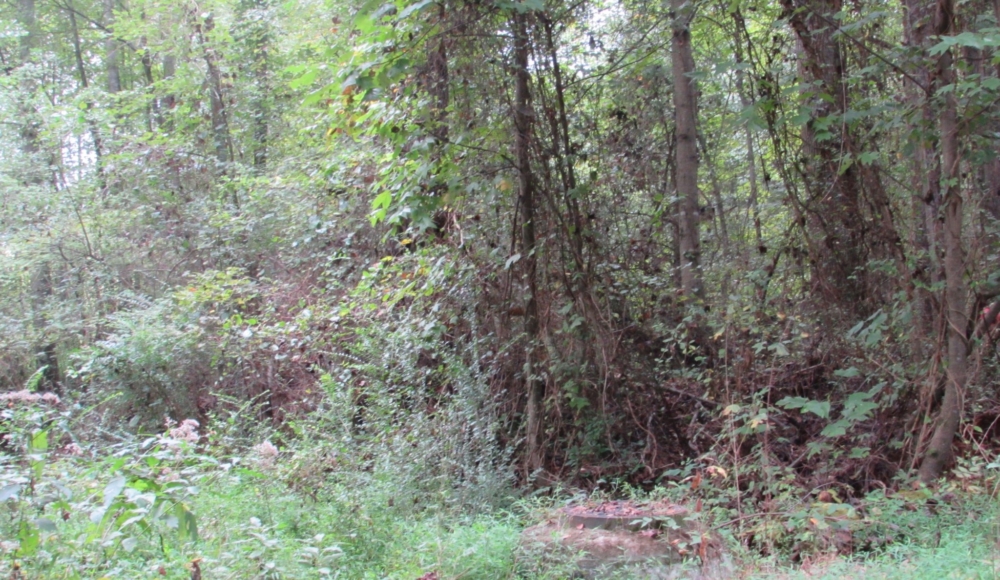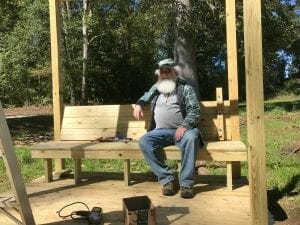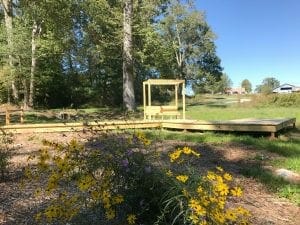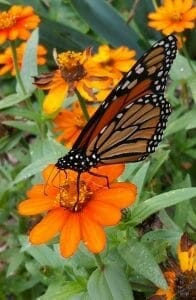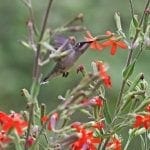Chapters in Georgia Native Plant Society
History
Over two decades ago, the Georgia Native Plant Society was founded by people based in metro Atlanta. Since that time, their initiative and message around the importance of native plants to our lives and the ability of individuals to make a difference locally in their protection, stewardship, rescue and propagation, has spread across Georgia and in fact across the USA. Today our members are served in other locations across the state where local groups are providing educational information, restoration opportunities and opportunities to learn more.
Realignment
In November 2019, GNPS adopted new bylaws, which implemented a state-wide governing board to set organizational policy, define its strategic vision, and directly support chapter activities. This new organizational structure paved the way for more chapters to form throughout Georgia.
Join a chapter
There are currently 8 chapters of the Georgia Native Plant Society. As a member of GNPS you too can get to work and join like minded people in your area by aligning yourself with one of our chapters.
For current members, login and update your chapter affiliation through the chapter affiliation form. For new or renewing members, select your chapter affiliation on the membership form.
Form a chapter
Let us know if you are interested in learning more about how to join or start up a local chapter near you in the state of Georgia by using the Contact Us form. Current members can also use the Chapter Interest Form. To learn more about the overall process, view the Chapter Quick Start Guide. For a more in-depth guide to forming and running a chapter, see the Chapter Manual.
News & Events
June 2018: West Georgia Chapter News
Marc Lafountain
The West Georgia Chapter has had a very busy Spring. In February our public program was “Native Plants in Carrollton Parks and on the Greenbelt”, presented by Kent Johnston, Director of Parks for Carrollton Parks, Recreation and Cultural Arts, who discussed the use and maintenance of native plants in Carrollton parks and along the 18 mile Carrollton GreenBelt, a paved walking/biking trail that traverses public and private lands.
In April our Spring Workshop, “Grow your own pollinator plants from seeds: Established practices for successful seed germination and transplanting seedlings of pollinator plants”, featured James Hembree, Grounds Superintendent at the University of West Georgia and an organic farmer. This was a hands on workshop focussing on how to successfully germinate and transplant the seedings of important pollinator plants. Each person took home seeds, transplants, and finished plants.
Also in April, we had the grand opening of the Meadow Entrance to the Buffalo Creek Trail where it meets the Carrollton GreenBelt. Once only a thicket of invasive plants and an overgrown meadow, this area now features a kiosk, boardwalk, pollinator garden, rain garden, meadow, and birdhouses. Members of local organizations and government who have made our work possible joined us for this celebration. We dedicated the boardwalk to our dear friend and founding member, Wendell Hoomes, who passed away earlier in the year.
Our June public program will be “Owls of Georgia”, presented by Jim Ozier, Wildlife Biologist, Environmental and Natural Resources, Georgia Power.
Photos clockwise from upper left: Spring propagation workshop, native clematis (Clematis pitcheri), Carol Hight and Diane Rooks on May 28 hike to Flat Shoal Creek in Harris County to see the shoals spider lilies, Fire Pink (Silene virginica). Both plant photos were from the creek hike.
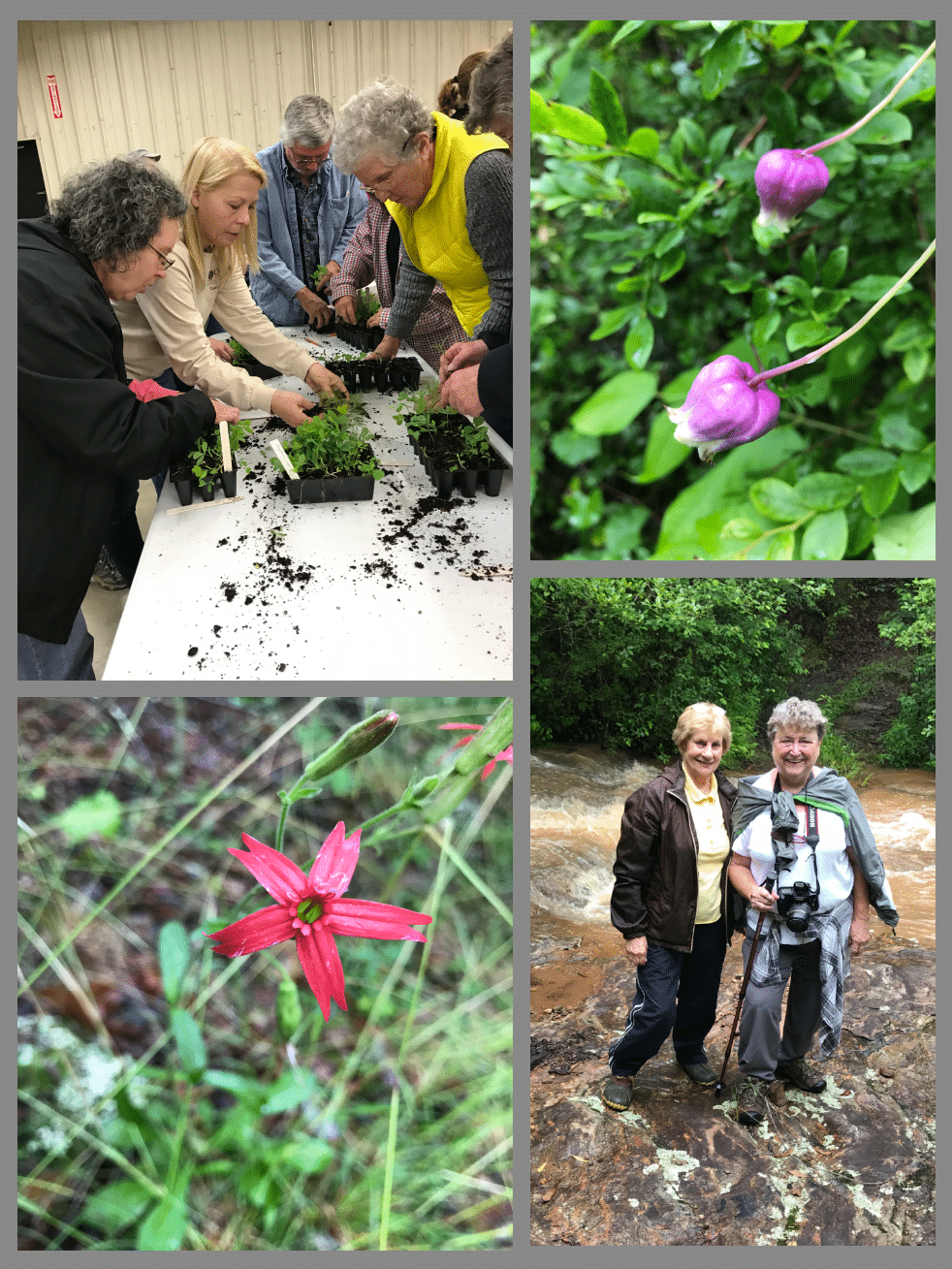
Photos clockwise from upper left: Spring propagation workshop, native clematis (Clematis pitcheri), Carol Hight and Diane Rooks on May 28 hike to Flat Shoal Creek in Harris County to see the shoals spider lilies, Fire Pink (Silene virginica). Both plant photos were from the creek hike.
Grand Opening of Meadow Entrance to Buffalo Creek Trail: April 17, 2018
On Tuesday, April 17, starting at 6:30 pm, members of the West Georgia Chapter of GNPS will hold the grand opening of the Meadow Entrance to the Buffalo Creek Trail as part of their 10th anniversary as an organization. The trail is part of the larger, 40-acre Buffalo Creek Outdoor Education Center, created by the Forestry Service and now entrusted to the West Georgia Chapter by the Carroll County Board of Commissioners for a term of 99 years. Invited guests include city and country government officials, master gardeners, numerous local garden clubs, civic groups, and local funding organizations. GNPS board members and some long-time key GNPS friends of the project have also been invited.
Buffalo Creek is probably the largest of the GNPS restoration sites. The Meadow Entrance was once an overgrown, often impassable link to a sewer line. Restoration workers have removed invasives and added a kiosk, bike rack, boardwalk, pollinator garden, split rail fencing, and birdhouses. Soon a rain/bog garden will go in around the boardwalk. This area links the Buffalo Creek Trail to the Carrollton GreenBelt, an 18 mile walking/bilking trail the circles Carrollton. It’s similar to the Atlanta Beltline, but it runs through both public and private lands. If you cannot make this event, try to find another time to visit! Follow the project on it’s own restoration site page.
Chapter News – November 2017
We appreciate our chapters so much, helping to bring activities even closer to our state-wide members. We have status from all 3 chapters this morning, so keep reading (and click to enlarge their pictures).
From the West GA Chapter in Carrollton:
Our chapter’s primary focus since late 2015 has been the beautification of the area where the Buffalo Creek Trail meets the Carrollton Green Belt, now known as the Meadow Entrance. The Carrollton Green Belt, similar to the Atlanta BeltLine, is an 18 mile paved walking/biking trail circling Carrollton. Unlike the BeltLine, which follows transit lines, the Green Belt traverses public and private lands and offers wonderful views of old farmland, forests, and wetlands, and access to downtown Carrollton and the University of West Georgia.
There is a parking lot at the Green Belt entrance next to the Meadow Area, where bikes can be rented and dropped off along the Green Belt. The Buffalo Creek Trail is now marked on the Green Belt map, so users can detour for a walk along the Trail as they use the Green Belt. After many hours of removing privet and other invasive plants, and with generous grants from the Community Foundation of West Georgia, the Carroll County Master Gardeners, and GNPS, we have added a kiosk, bike rack, bench, pollinator garden, birdhouses, and split rail fencing to the Meadow area. Gina and Mike Strickland donated a boardwalk and funds for planting a rain garden/bog in the Meadow area. The boardwalk has just been completed and planting will begin soon. Signage will follow. A couple pictures of the construction are below.
Note: We, unfortunately, had to cancel our October program on mason bees and bumblebees due to the death of our speaker, Nick Stewart. We hope to find another speaker and reschedule it for 2018.
From the Coastal Plain Chapter in Tifton:
The Coastal Plain Chapter, GNPS will hold its annual business meeting on November 4 at the Altama Plantation near Brunswick, GA. There will be a short business meeting to elect officers, recap this year’s activities and plan for the coming year. Heather Alley with UGA State Botanical Garden will present on their Connect to Protect Program. This project provides the public information, plant materials and educational tools for teaching the significance of incorporating native plants on large and small scales alike! We will also discuss a Coastal Plain Milkweed Initiative, followed by a tour of a 1930’s era formal garden & explore the Altama property.
On October 21st Coastal Plain Chapter, GNPS helped sponsor the third annual Butterfly, Bees, and Beyond Symposium at Vincent Gardens in Douglas, GA. The meeting was well attended with persons attending from as far away as St Mary’s and Warner Robins. Activities included: a Wildlife Habitat Walkabout by Donna Vincent, an introduction to the Rosalyn Carter Butterfly Trail by Annette Wise, Backyard Wildlife – Birds by Noah McCord, and Edible Landscaping with Natives by Katherine Melcher. In the afternoon, participants were treated to break out make and take sessions that included propagating from cuttings by Donna Vincent and making cast stone butterfly waterers by Amy Heidt and Karan Rawlins. Participants were able to take home cuttings to be rooted and a butterfly waterer for their gardens.
From the Redbud Chapter in Gainesville:
The Redbud Chapter presented a program on rain gardens for Building Green Infrastructure to Water Quality at Lake Lanier and Oconee Basin Advisory Board of Metro Water Districts held Tuesday, Oct 24 at the Linwood Ecology Center.
We also continued our community engagement effort with testing of monarchs for the protozoan parasite OE (see pictures below). This is something we learned about in our June 2016 meeting with speaker Paola Barriga (Post-doctoral Researcher, Odum School of Ecology, University of Georgia, Athens). She is part of Altizer labs doing this research. This website has more info: https://www.altizerlab.org/research-1
We have a field trip coming up on November 8th: Thompson Mills Forest – Georgia State Arboretum, 1740 New Liberty Church Rd. Bill Lott will be our guide for a 10-12pm Walk & Talk, followed by 12-1pm Lunch (BYOBag Lunch) Q&A.
For 2018, we are working on a Gainesville Ridges Native Plant ID Certification Workshop Series. Stay in touch with us for details.
WGA Chapter Hosts 7th Annual Fall Festival
Mark your calendar for the Georgia Native Plant Society – West Georgia Chapter 7th Annual Fall Workshop. The WGA Chapter has been putting on this free event for 7 years in a row to help the public learn more about native plants.
Registration is from 8-8:45 and the program features 3 presentations:
Gail Woody will speak on “The 3 B’s of a Flower Garden: Birds, Bees, and Butterflies”
Robert Barr will speak on “Container Bog Gardening with Carnivorous Plants”
The keynote speaker will be Wilf Nichols, PhD, director of the State Botanical Garden of Georgia. Dr. Nichols will talk about “Growing Native Plants-Some Pitfalls, Pratfalls, and Downfalls”
Breaks throughout the day will allow for visiting vendors who will be selling plants and garden items until the event ends at 12:30 pm.
No pre-registration required, free admission ($5 donation to cover costs is suggested).
Native plants will be available for purchase from vendors including:
- Ernest Koone of Lazy K Nursery and Garden Delights Garden Center in Pine Mountain, GA – native azaleas and shrubs.
- Robert and Patsy Barr of Barr Gardens – bog and pitcher plants.
- Night Song Native Plant Nursery – perennials and shrubs.
For location details, please see our calendar event: https://gnps.org/calendar-event/annual-fall-workshop-wga-chapter/
From one pitcher plant bog, four more may grow thanks to DNR, state parks, dedicated volunteers of the Georgia Native Plant Society
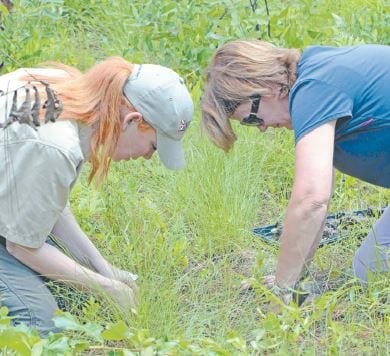
Rebecca Byrd of the Georgia DNR and Amy Heidt, GNPS set out milkweed at General Coffee State Park
The clod of potting soil in a state park employee’s hand is dusted with fragile green leaves. When it is planted into the ground, this seedling will disappear amid grasses and other plants. But a lot of hopes ride on this bit of greenery and more like it — six years and more of advocacy, fund raising, seed collecting and greenhouse growing.
It was just six years ago that Abraham Baldwin Agricultural College found itself in possession of a pitcher plant bog, 8.74 acres of land where some of Georgia’s most unusual plants have grown for decades. Seven species of the insect-eating pitcher plants grow in the state.
All seven are protected, due to widespread loss of habitat, and at least one is endangered. They are among the most unusual plants in the world.
Ben Mills of Fitzgerald had put the property on the market, but when approached by a group of botanists, biologists and native plant lovers, he agreed to donate half his asking price, if the group could come up with the rest. They did, and the bog was then turned over to the care of the ABAC Foundation to be used as a living lab for biology and natural resource management students.
This year, thanks to members of the Coastal Plain Chapter of the Georgia Native Plant Society, ABAC, employees of the Georgia Department of Natural Resources’ non-game and state parks divisions and the University of Georgia and private landowners, the ABAC bog has contributed to an effort to establish new bogs in four state parks: General Coffee near Douglas, Little Ocmulgee near McRae, Reed Bingham near Adel and Laura S. Walker near Waycross.
Georgia’s state parks are attempting to return native plants to their natural “homes” within the parks. The parks are also engaged in a related federal effort to plant native milkweed for monarch butterflies and other pollinators, including bees. Pollinator gardens have now been established in most of Georgia’s state parks.

Millie Davidson with Pitcher Plant Seedlings
“We have been working on habitat restoration statewide,” says Lisa Kruse, a rare plant botanist with the non-game division of the DNR. “Certain parks have high priority rare habitats.” These would include parks with wetland habitats like bogs, which are fast disappearing from the Georgia landscape.
The non-game section of DNR works in partnership with the state parks to help with park management. “State parks don’t have a lot of funding for natural resource development,” Kruse points out. The work to restore native habitats has several aspects, including, in South Georgia, prescribed burns. These are critical in the coastal plain where plants and wildlife evolved under conditions of frequent, low-intensity fires (caused by lightning or drought) that periodically burned off understory plants. With modern fire prevention on wild lands, such naturally caused fires have become rare.
Prescribed burns benefit longleaf pines, pitcher plants, gopher tortoises and indigo snakes, among others, all dependent on sunny, open grasslands for survival. Many of these species are now endangered. Other aspects of habitat restoration include getting rid of invasive, non-native plants (such as mimosa trees, Chinese wisteria, Chinese privet, chinaberry, water hyacinth and kudzu) and removing hardwoods where the canopy is too crowded to let in enough sunlight. It’s a lot of work, but Kruse says, “We have good networks of partners, and it’s a lot of fun, too. I’m always learning new things.”
The prescribed burn program was started 10 years ago. “We have made significant progress toward restoration,” Kruse said. “It’s time to put native plants back in place.” The chain of events that led to the recent plantings began with a federal grant through the U.S. Fish and Wildlife Service to the Atlanta Botanical Garden to provide milkweed plants to restore to its native habitats this species vital to monarch butterflies, honey bees and other pollinating insects. “They couldn’t find a source of native, locally grown milkweed,” Kruse says. Commercial varieties would not do.
“They really needed seed collected from Georgia habitats. This is incredibly local, which is really exciting.” To fulfill its obligation, the botanical garden collected the seeds in the wild and hundreds of the seedlings they grew were planted in three state parks in South Georgia.
Sim Davidson, resource manager for the Southern region of Georgia State Parks, received an email from biologist Nathan Klaus about the availability of milkweed for planting in state parks. He and Kruse discussed suitable locations for planting in the region and settled on three, General Coffee, Reed Bingham and Laura S. Walker. And Kruse contacted her friend Karan Rawlins of Tifton. Rawlins is a biologist with the University of Georgia’s Center for Invasive Species and Ecosystem Health (also called the Bugwood Network). With the involvement of Rawlins and Amy Heidt, president of the Coastal Plain Chapter of the Georgia Native Plant Society, the scope of the project expanded.
Rawlins is also a member of the Coastal Plain Chapter of the GNPS, an organization that supports the conservation of Georgia’s native plants. The CPC had pitcher plants in need of homes. “I do a lot of seed collecting and work to develop relationships with local landowners who give me permission to collect seed from their property,” Rawlins explains. All collecting is done using Georgia DNR-recommended techniques designed to protect the parent plants so they will remain healthy and unaffected. The DNR must also approve ahead of time where seed will be planted, Rawlins says.
With ABAC’s permission, Rawlins collected the seeds of Sarracenia flava, commonly called yellow trumpets, and Sarracenia minor, or hooded pitcher plants, from the Turner County bog. In her greenhouse, Amy Heidt grew seedlings from pitcher plant seeds from a bog on her property. “I had first gotten interested in growing native plants in my own landscape,” Heidt says. Her interest led to her involvement with the GNPS and the local chapter when it was formed three or four years ago to promote awareness and use of Georgia’s wonderful native plants in this area.
“They offered to donate pitcher plants” to the three parks, Davidson says of Rawlins and Heidt. The proposal was a natural fit with DNR plans. Davidson also requested some of the pitchers for Little Ocmulgee State Park, where he is based. Pitcher plants had previously grown in a bog in the park and he hopes to reestablish them.
Kruse, Davidson, Rawlins, Heidt and others met with park personnel, managers and rangers two weeks ago to start planting. They began at the Coffee County park on May 17, went to Cook County’s Reed Bingham on May 18 and ended at Laura S. Walker on May 19. Davidson took the remaining pitcher plants to set out at Little Ocmulgee. “We all had a blast,” Rawlins says, “and a lot of good, very satisfying work was accomplished. Nature cooperated by raining on the plantings.”
During those three days, several hundred sandhill milkweed (Asclepias humistrata) plants, grown by the Atlanta Botanical Garden, and a total of 1,500 pitcher plants and seeds were set out in suitable habitat, safe from development or other use. “The project was specifically designed for planting on Georgia conservation lands where the plants are protected and habitat management is known,” Kruse says.
By planting in state parks, the DNR is able to also engage landowners and other members of the community. “The plants are in areas along trails with public access,” Kruse notes, “and they will provide excellent opportunities for education about the importance of native wildflowers and habitat diversity.” State park personnel will monitor the plants over the summer. For all concerned with the pitcher plants, this is an important experiment. “They are learning how to outplant the pitcher plants, and we’ll see how they do,” Kruse says.
From one bog, rescued by people who are passionate about Georgia’s native habitats, plants and creatures, carefully managed by ABAC, with the collaboration of state agencies and, incidentally, a federal program, these unusual, insect-eating plants may have the beginnings of a comeback in their South Georgia home.
Article by Sherri Butler, June 1, 2016 edition of the Herald-Leader of Fitzgerald, Georgia



